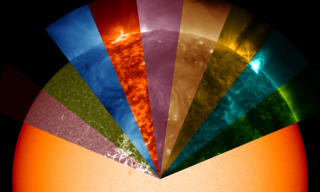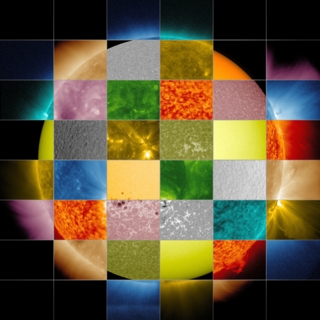Solar Continuum
Many of the sun's features are invisible to the naked eye. To paint a full picture of our constantly changing star, scientists use telescopes launched into space. Each telescope is outfitted with special filters that can see the sun in different wavelengths of light. To track how material and heat of different temperature moves through the sun's atmosphere, scientists only need to select the specific wavelength with which a feature can best be seen. Watch the video for a tour of the wide range of wavelengths that NASA's Solar Dynamics Observatory spacecraft uses to observe the sun.

Scientists learn about the sun by watching it in different wavelengths of light.
Each wavelength is represented by a single color. Notice how the sun's look changes when viewed in multiple wavelengths.

The sun and its atmosphere are shown here in ten different wavelengths.

Each wavelength provides scientists with a different view of what is happening on the sun.

This chart shows the wavelengths that NASA's Solar Dynamics Observatory uses to view various features of the sun.
For More Information
See NASA.gov
Credits
Please give credit for this item to:
NASA's Goddard Space Flight Center
-
Animator
- Tom Bridgman (Global Science and Technology, Inc.)
-
Video editor
- Genna Duberstein (USRA)
-
Producer
- Genna Duberstein (USRA)
-
Scientists
- William D. Pesnell (NASA/GSFC)
- C. Alex Young (NASA/GSFC)
- Barbara Thompson (NASA/GSFC)
-
Writer
- Karen Fox (ADNET Systems, Inc.)
Release date
This page was originally published on Thursday, January 2, 2014.
This page was last updated on Wednesday, May 3, 2023 at 1:51 PM EDT.


